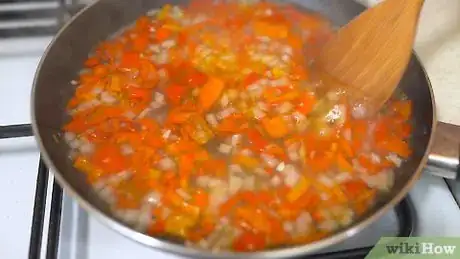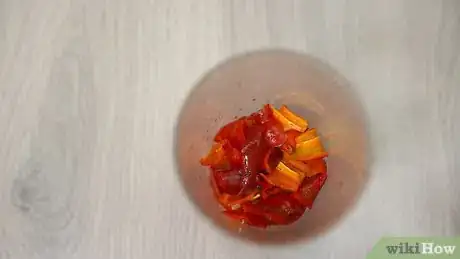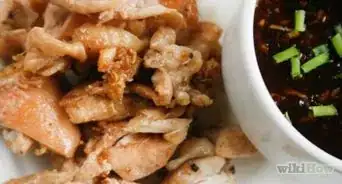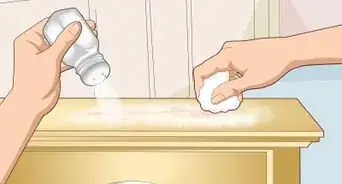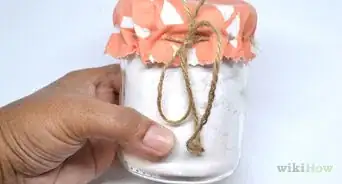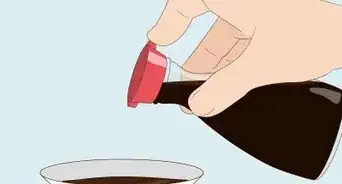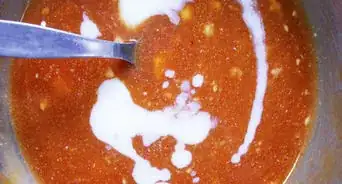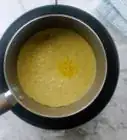This article was co-authored by wikiHow staff writer, Jessica Gibson. Jessica Gibson is a Writer and Editor who's been with wikiHow since 2014. After completing a year of art studies at the Emily Carr University in Vancouver, she graduated from Columbia College with a BA in History. Jessica also completed an MA in History from The University of Oregon in 2013.
There are 10 references cited in this article, which can be found at the bottom of the page.
The wikiHow Culinary Team also followed the article's instructions and verified that they work.
This article has been viewed 919,271 times.
Learn more...
Sure, there are a lot of hot sauces on the market, but it's so much fun to make your own! Most hot sauces rely on fresh or dried chili peppers, and you can customize your sauce by using your favorite peppers or a mix. Add a hefty amount of vinegar to get the classic tangy flavor and play around with adding seasonings or other veggies. Store the hot sauce in the fridge and add it to any dish that needs a little kick.
Ingredients
- 20 tabasco or serrano chiles or 12 red jalapeños
- 1 1/2 tablespoons (13 g) of minced garlic
- 3/4 cup (115 g) of thinly sliced onions
- 3/4 teaspoon (4.5 g) of salt
- 1 teaspoon (4.9 ml) of vegetable oil
- 2 cups (470 ml) of water
- 1 cup (240 ml) of distilled white vinegar or apple cider vinegar
- 1⁄4 cup (59 ml) of freshly squeezed lime juice, optional
Makes 2 cups (470 ml) of hot sauce
- 1 pound (0.45 kg) of fresh chiles like jalapeño, serrano, Fresno, habanero or a mix
- 2 tablespoons (36 g) of kosher salt or 4 teaspoons (35 g) of table salt
- 1 1⁄2 cups (350 ml) of distilled white vinegar or apple cider vinegar
- 1 sliced onion, optional
- 4 cloves of peeled garlic, optional
Makes 2 1⁄2 cups (590 ml) of hot sauce
- 2 cups (128 g) of lightly crushed and seeded dried chili peppers
- 1 cup (240 ml) of water
- 1 cup (240 ml) of white vinegar
- 1 teaspoon (3 g) of garlic powder
- 1 teaspoon (6 g) of salt
- 1 chopped onion, optional
- 2 cloves of peeled garlic, optional
- Citrus juice, to taste, optional
Makes 2 1⁄2 cups (590 ml) of hot sauce
Steps
Making Basic Red Hot Sauce
-
1Chop 20 tabasco or serrano chilies or 12 red jalapeños. You can use a mix of tabasco and serrano chilies or stick with just red ripe jalapeños. Serranos are 5 times hotter than jalapeños, so if you use a combination, adjust the heat by how many serranos you use. Rinse your choice of peppers. Then, trim the stems from the chili peppers and finely chop the peppers.[1]
- Remove the seeds for a milder sauce.
-
2Sauté the peppers with garlic, onions, and salt for 3 minutes. Heat 1 teaspoon (4.9 ml) of vegetable oil in a skillet over high heat and add the chopped peppers along with 1 1/2 tablespoons (13 g) of minced garlic, 3/4 cup (115 g) of thinly sliced onions, and 3/4 teaspoon (4.5 g) of salt. Stir the mixture occasionally and cook it for about 3 minutes so the peppers soften.[2]
- Turn the burner down to medium-high if the peppers stick to the skillet.
- You'll need about 4 cloves of garlic to get 1 1/2 tablespoons (13 g) of minced garlic and a medium-sized onion to get 3/4 cup (115 g) of sliced onions.
Advertisement -
3Pour in the water and simmer the mixture for 20 minutes. Add 2 cups (470 ml) of water and turn the burner down to medium-high heat. Cook the peppers until the peppers are really soft and almost all of the water has evaporated or been absorbed.[3]
- Keep the lid off of the skillet while the peppers cook and stir them occasionally to prevent them from sticking to the skillet.
-
4Put the cooled mixture into a blender and process it for 15 seconds. Turn off the burner and let the pepper mixture cool for about 30 minutes. Then, transfer it to a blender and put the lid on. Blend the sauce for 15 seconds or until it's completely smooth.[4]
- If you don't have a blender, use a food processor.
-
5Blend in 1 cup (240 ml) of white vinegar. Open the pour spout in the top of the blender's lid and slowly pour in 1 cup (240 ml) of white distilled vinegar while you blend the hot sauce.[5]
- For a slight citrus flavor, add 1⁄4 cup (59 ml) of freshly squeezed lime juice.
- Use apple cider vinegar for a slightly sweet, fruity flavor.
-
6Strain the sauce and store it in a bottle in the fridge. Taste the hot sauce and add more vinegar, salt, or water according to your taste. Then, set a fine-mesh strainer over a large measuring jug and strain the sauce. Pour the sauce into an airtight glass storage bottle and refrigerate it.[6]
- Choose a bottle that holds 2 cups (470 ml).
- The flavor of the sauce improves after resting in the fridge for a few weeks.
- Store the homemade hot sauce in the fridge for up to 6 months.
Creating Fermented Hot Sauce
-
1Put 1 pound (450 g) of rinsed and trimmed chilies into a blender. You can really customize the flavor of your hot sauce by selecting your favorite chilies. Use 1 pound (450 g) of a single type of chili pepper or mix several to create a unique blend. For example, to make:[7]
- Red hot sauce: use red bell peppers, cayenne peppers, and red habaneros.
- Green hot sauce: use green bell peppers, jalapeños, and poblanos.
-
2Pulse the chili peppers with salt. You can use 2 tablespoons (36 g) of kosher salt or 4 teaspoons (35 g) of table salt. The salt makes the base of the brine that ferments the chili peppers. Put the lid on the blender and pulse the chilies until they form a chunky purée.[8]
- If you don't have kosher salt, use table salt instead.
-
3Put the puree into a large jar and store it at room temperature for 12 hours. Slowly pour the chili pepper puree into a 1 US qt (0.95 L) jar. Set a lid on the jar and screw it on loosely. Then, set the jar on the counter and leave the pepper mixture to ferment for 12 hours.[9]
- Feel free to add other flavorful ingredients to the fermenting mixture. Try adding a sliced onion or 4 cloves of peeled garlic, for instance.
-
4Stir in 1 1⁄2 c (350 ml) of white vinegar and ferment it for at least 1 day. Remove the lid and pour in 1 1⁄2 c (350 ml) of distilled white vinegar. Stir the sauce and loosely put the lid back. Then, leave the sauce at room temperature for at least 1 day or up to 1 week.[10]
- If you'd like the hot sauce to have a slightly fruity flavor, use apple cider vinegar instead of white vinegar.
- The sauce becomes more flavorful and stronger the longer it ferments.
-
5Pour the sauce into a blender and blend it until it's smooth. Taste the hot sauce to decide if it's as fermented as you want. If it is, transfer the sauce to a blender and blend it for about 1 minute so it's completely smooth.[11]
- If you don't have a blender, use a food processor.
-
6Pour the sauce through a fine-mesh strainer. Set a large bowl or measuring jug in the sink and put a fine-mesh strainer in it. Slowly pour the sauce into the strainer so the smooth, thin sauce drains into the bowl.[12]
- If you want your sauce to be thick, skip this straining step.
-
7Transfer the sauce to a small bottle. Get out an airtight glass bottle that holds at least 2 1⁄2 cups (590 ml) and put a funnel in it so it's easier to pour in the sauce. Slowly pour the hot sauce into the bottle and screw the lid on.[13]
- Shake the sauce before you use it since the solids might separate over time.
- Store the fermented hot sauce in the fridge for up to 4 months.
Cooking Dried Pepper Hot Sauce
-
1Toast 2 cups (128 g) of dried chili peppers in a skillet for 1 to 2 minutes. Set a deep skillet on the stove and turn the burner to medium-high. Add 2 cups (128 g) of lightly crushed and seeded dried chili peppers, but don't put oil in the skillet. Stir the peppers and heat them just so they start to soften.[14]
- Don't rinse the dried chilies before you toast them or they'll steam in the skillet.
- Arbol and guajillo chiles work really well together, but you could use ancho or poblanos, for instance.
- Toasting the chili peppers gives them a deeper flavor, but if you're short on time, skip this step.
-
2Add water, white vinegar, garlic powder, and salt to the skillet. Pour in 1 cup (240 ml) of water and 1 cup (240 ml) of vinegar. Then, stir in 1 teaspoon (3 g) of garlic powder and 1 teaspoon (6 g) of salt.[15]
- Feel free to play around with the ratio of water and vinegar. If you want tangier sauce, use 2 cups (470 ml) of vinegar and leave out the water. For a milder sauce, use all water instead of vinegar.
- Add a few cloves of garlic or a chopped onion if you want the sauce to have a richer flavor.
-
3Simmer the sauce over medium heat for 15 to 20 minutes. Turn the burner down to medium and stir the sauce every few minutes. Cook the sauce until the chili peppers soften. This makes them easier to blend.[16]
- If the sauce begins to boil, turn the burner down to medium-low.
-
4Blend the hot sauce until it's smooth. Turn off the burner and very carefully pour the mixture into a blender or food processor. Put the lid on the blender and blend the sauce until it's smooth.
- Wear oven mitts when you transfer the sauce to the blender since the sauce can burn your skin.
-
5Taste the sauce and add more vinegar, salt, or water if you like. Decide if you want to adjust the flavor before you store the hot sauce. For a tangier sauce, add a little more vinegar. If the sauce is too thick or spicy, thin it with a little water.[17]
- To give your sauce a slight citrus flavor, squeeze in some lemon, lime, or orange juice.
-
6Pour the hot sauce into a bottle. Let the sauce cool to room temperature. If you want a thinner sauce, pour the sauce through a fine-mesh strainer before you bottle it. Then, put a funnel into a glass storage bottle and slowly pour the hot sauce into it.[18]
- Use a bottle that holds at least 2 1⁄2 cups (590 ml).
-
7Store your sauce in the refrigerator for up to 2 months. Remember to label the bottle and keep it in the fridge until you're ready to use it. Shake the bottle before you pour it on food since the solids might settle to the bottom.[19]
- For longer storage, put the sauce in the freezer and use it within 6 months.
Community Q&A
-
QuestionHow long will this sauce still be good to eat?
 Community AnswerThe vinegar acts as a preservative, so as with store-bought hot sauce, once you open it, put it in the refrigerator, and the flavor should be optimal for up to 6 months. Although it will take a long time to actually spoil, the flavor will slowly degrade after that time.
Community AnswerThe vinegar acts as a preservative, so as with store-bought hot sauce, once you open it, put it in the refrigerator, and the flavor should be optimal for up to 6 months. Although it will take a long time to actually spoil, the flavor will slowly degrade after that time. -
QuestionHow can I make a hot sauce milder?
 Community AnswerAdd something sweet - sugar, honey, etc. Add a little bit at a time and taste. You don't want the sweetness overwhelming the flavor of the sauce.
Community AnswerAdd something sweet - sugar, honey, etc. Add a little bit at a time and taste. You don't want the sweetness overwhelming the flavor of the sauce.
Warnings
- Wear gloves when you work with fresh hot peppers since the oils can irritate your skin. Wash your hands really well when you're done, especially before touching your face.⧼thumbs_response⧽
- Open a window and turn on a kitchen fan to ventilate your space. This can prevent oil from the chili peppers from irritating your eyes or lungs.⧼thumbs_response⧽
Things You'll Need
Basic Red Hot Sauce
- Knife and cutting board
- Measuring cups and spoons
- Skillet
- Spoon
- Blender or food processor
- Fine-mesh strainer
- Funnel
- Storage bottle
Fermented Hot Sauce
- Knife and cutting board
- Measuring spoons
- Blender or food processor
- 1 US qt (0.95 L) 1-quart jar with a lid
- Fine-mesh strainer
- Storage bottle
- Funnel
- Large bowl or measuring jug
Dried Pepper Hot Sauce
- Measuring cups and spoons
- Deep skillet
- Spoon
- Blender or food processor
- Storage bottle
- Funnel
References
- ↑ https://www.foodnetwork.com/recipes/homemade-red-hot-sauce-3645026
- ↑ http://www.eatingwell.com/recipe/252949/homemade-hot-sauce/
- ↑ https://www.tasteofhome.com/recipes/homemade-spicy-hot-sauce/
- ↑ https://www.foodnetwork.com/recipes/homemade-red-hot-sauce-3645026
- ↑ https://www.tasteofhome.com/recipes/homemade-spicy-hot-sauce/
- ↑ https://www.foodnetwork.com/recipes/homemade-red-hot-sauce-3645026
- ↑ https://wholefully.com/homemade-hot-sauce-recipe/
- ↑ https://www.bonappetit.com/recipe/master-hot-sauce
- ↑ https://www.chilipeppermadness.com/recipes/fermented-hot-sauce/
- ↑ https://wholefully.com/homemade-hot-sauce-recipe/
- ↑ https://www.bonappetit.com/recipe/master-hot-sauce
- ↑ https://www.chilipeppermadness.com/recipes/fermented-hot-sauce/
- ↑ https://www.bonappetit.com/recipe/master-hot-sauce
- ↑ https://youtu.be/nrgwfS2EqjI?t=104
- ↑ https://www.chilipeppermadness.com/recipes/how-to-make-hot-sauce-from-dried-peppers/
- ↑ https://www.mexicoinmykitchen.com/homemade-red-hot-sauce-recipe/
- ↑ https://youtu.be/nrgwfS2EqjI?t=249
- ↑ https://www.chilipeppermadness.com/recipes/how-to-make-hot-sauce-from-dried-peppers/
- ↑ https://www.chilipeppermadness.com/recipes/how-to-make-hot-sauce-from-dried-peppers/
About This Article
To make hot sauce, start by putting minced garlic, diced onion, deseeded hot peppers and tomato sauce into a food processor or blender. Then, puree the mixture until it’s smooth and pour it into a saucepan. Next, bring the sauce to a simmer over medium heat before adding some vinegar. Finally, strain the hot sauce into a jar to remove any chunks before using it. For tips on picking the right types of peppers for your hot sauce, keep reading!

